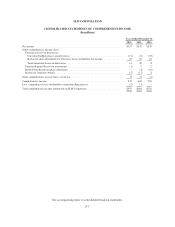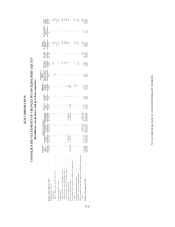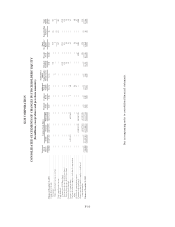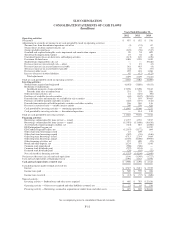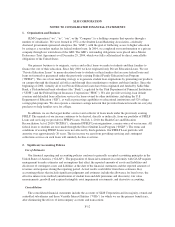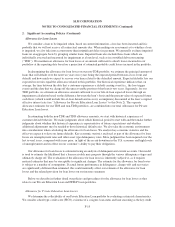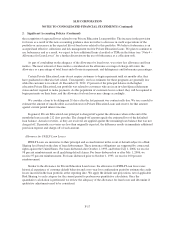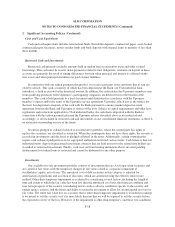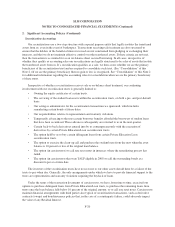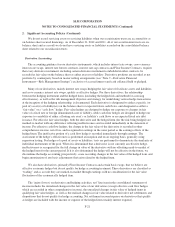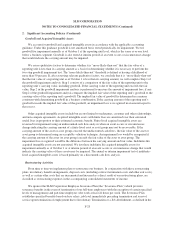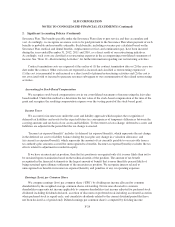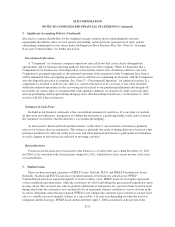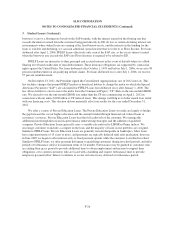Sallie Mae 2012 Annual Report Download - page 126
Download and view the complete annual report
Please find page 126 of the 2012 Sallie Mae annual report below. You can navigate through the pages in the report by either clicking on the pages listed below, or by using the keyword search tool below to find specific information within the annual report.SLM CORPORATION
NOTES TO CONSOLIDATED FINANCIAL STATEMENTS (Continued)
2. Significant Accounting Policies (Continued)
quality indicators because they have the most significant effect on our determination of the adequacy of our allowance
for loan losses. The type of school customers attend can have an impact on their job prospects after graduation and
therefore affects their ability to make payments. Credit scores are an indicator of the creditworthiness of a customer
and generally the higher the credit score the more likely it is the customer will be able to make all of their contractual
payments. Loan status affects the credit risk because generally a past due loan is more likely to result in a credit loss
than an up-to-date loan. Additionally, loans in a deferred payment status have different credit risk profiles compared
with those in current pay status. Loan seasoning affects credit risk because a loan with a history of making payments
generally has a lower incidence of default than a loan with a history of making infrequent or no payments. The
existence of a cosigner lowers the likelihood of default. We monitor and update these credit quality indicators in the
analysis of the adequacy of our allowance for loan losses on a quarterly basis.
To estimate the probable credit losses incurred in the loan portfolio at the reporting date, we use historical
experience of customer payment behavior in connection with the key credit quality indicators and incorporate
management expectation regarding macroeconomic and collection procedure factors. Our model is based upon
the most recent six months of actual collection experience, seasonally adjusted, as the starting point and applies
expected macroeconomic changes and collection procedure changes to estimate expected losses caused by loss
events incurred as of the balance sheet date. Our model places a greater emphasis on the more recent default
experience rather than the default experience for older historical periods, as we believe the recent default
experience is more indicative of the probable losses incurred in the loan portfolio today. Similar to estimating
defaults, we use historical customer payment behavior to estimate the timing and amount of future recoveries on
charged-off loans. We use judgment in determining whether historical performance is representative of what we
expect to collect in the future. We then apply the default and collection rate projections to each category of loans.
Once the quantitative calculation is performed, we review the adequacy of the allowance for loan losses and
determine if qualitative adjustments need to be considered. Additionally, we consider changes in laws and
regulations that could potentially impact the allowance for loan losses. More judgment has been required over the
last several years, compared with years prior, in light of the U.S. economy and its effect on our customer’s ability
to pay their obligations. We believe that our model reflects recent customer behavior, loan performance, and
collection performance, as well as expectations about economic factors.
Similar to the rules governing FFELP payment requirements, our collection policies allow for periods of
nonpayment for customers requesting additional payment grace periods upon leaving school or experiencing
temporary difficulty meeting payment obligations. This is referred to as forbearance status and is considered
separately in our allowance for loan losses. The loss confirmation period is in alignment with our typical
collection cycle and takes into account these periods of nonpayment.
On July 1, 2011, we adopted new guidance that clarified when a loan restructuring constitutes a TDR. In
applying the new guidance we determined that certain Private Education Loans for which we grant forbearance
of greater than three months should be classified as TDRs. If a loan meets the criteria for troubled debt
accounting then an allowance for loan losses is established which represents the present value of the losses that
are expected to occur over the remaining life of the loan. This accounting results in a higher allowance for loan
losses than our previously established allowance for these loans as our previous allowance for these loans
represented an estimate of charge-offs expected to occur over the next two years (two years being our loss
confirmation period). The new accounting guidance was effective as of July 1, 2011 but was required to be
applied retrospectively to January 1, 2011. This resulted in $124 million of additional provision for loan losses in
the third quarter of 2011 from approximately $3.8 billion of student loans being classified as TDRs. This new
accounting guidance is only applied to certain customers who use their fourth or greater month of forbearance
since the time period this new guidance is effective. This new accounting guidance has the effect of accelerating
F-16



